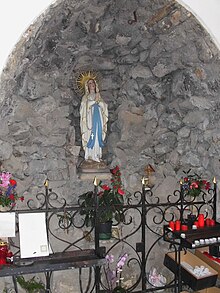Maria Helfbrunn
Helfbrunn is an Austrian Marian pilgrimage site with the pilgrimage church Maria Helfbrunn . Helfbrunn is located in the village of Ratschendorf , municipality of Deutsch Goritz , district of Southeast Styria . The church is the only pilgrimage church in the district.
The main pilgrimage days are the Assumption of Mary on August 15th and the Birth of Mary on September 8th. From May through October there is a Fátimo service in the evening on the 13th of every month . In May, May devotions are also held on Sundays, public holidays and Tuesday evenings. Occasionally there are also baptisms or weddings in the Helfbrunn church. Otherwise the place is visited privately by pilgrims.
History and creation
Maria Helfbrunn was visited by sick people in the hope of healing from the middle of the 17th century at the latest. The first written mention is from 1716. Even back then, people would have bathed in the “Helffbrun”, prayed in honor of St. Mary and placed an offering money in the well. This bathing activity with religious exercises has developed into a kind of pilgrimage without the involvement of the official church. Soon there was a negative attitude towards this pilgrimage on the part of the Straden parish , to which Helfbrunn belonged at the time. In the following hundred years a lot was done by the Straden parish to bring the pilgrimage to Helfbrunn to a standstill, but this did not succeed.
A cattle herder by the name of Michael Tell (also called Dell or Tornell) advertised the pilgrimage to Helfbrunn by walking the whole area, many miles into the windy Büheln, with a bottle of Helfbrunn water, according to a statement of facts from 1740 and spread wondrous stories about Helfbrunn. He has z. B. spreads “that whoever drinks from this water or goes on a pilgrimage to the Helffbrunnen, and bathes himself there, will recover from all kinds of infirmity or illness.” Tell also has a wooden hut above the well, which was used as a bathhouse and for prayer built. He was the first to set up an organized pilgrimage in Maria Helfbrunn.
With the sacrifice money, the rulers of Strass are said to have built an inn next to the fountain. The rulers were accused of tolerating that Tell act as a kind of lifeguard and hold "Winkelandachten" (Winkelandacht = religious devotion without the consent of a priest). The documents found in the archives of the diocese and the parishes of Straden and Mureck regarding Helfbrunn are characterized by the dispute over sacrifice money, corner landings and allegations about the morality of bathing.
The turning point came around 1850 when the municipality of Ratschendorf , to which Helfbrunn also belonged, came to the parish of Mureck . The Mureck parish no longer hindered pilgrimages and church building, but promoted them. In 1856 a small church was built on the hill above the wooden well chapel, which was expanded to its present size in 1898. In 1881 the wooden chapel above the source (fountain) was removed and a grotto was built based on the model of the French pilgrimage site Lourdes . In the church at the high altar behind glass there is said to be the statue of Mary that was originally in the wooden chapel above the "Helfbrunn". On the left and right in the niches on the altar are statues of Joachim and Anna , Mary's parents. Located to the right of the ambo (embedded in the wall) behind glass is the bust of the Duchess von Berry (1798–1870), who had to flee from France after the murder of her first husband and bought Brunnsee Castle. She was married to Count Lucchesi-Palli for the second time and gave Helfbrunn a lot of support.
The legend
Various legends , which differ greatly in their versions, describe the origins of the pilgrimage in Maria Helfbrunn. One of the most famous legends reports:
- The legend tells that there was once a thorn bush on which a picture of the Holy Virgin was found. - The pious people of the area began to diligently visit and venerate the picture. This veneration soon increased. The most blessed virgin appeared to a youth in a foreign country with the signification: he should make a pilgrimage here, the image of the holy. Go to the virgin by the well, wash there, and he will recover from the illness that he had had for several years. The young man, following Mary's admonition, came here, washed himself in the spring, and lo and behold, he was helped; hence the name Maria Helfbrunn.
Individual evidence
- ↑ B. Pöttler, H. Kranzelbinder: The pilgrimage Maria Helfbrunn. All holy times once . Publishing house for collectors 1994
- ↑ H. Kranzelbinder, G. Prutsch, FJ Schober (ed.): Ratschendorf. About becoming a village. Ratschendorf municipality 1997.
Web links
Coordinates: 46 ° 44 ′ 35 " N , 15 ° 47 ′ 52" E


